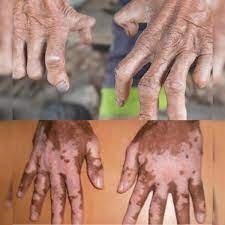
Leprosy

26-12-2023
Leprosy
|
For Prelims:About Leprosy,Transmission,Symptoms,National Leprosy Eradication Programme (NLEP) |
Why In the news?
The Odisha government recently declared leprosy a reportable disease in the state.
About Leprosy:
- It is also known as Hansen’s disease, is a chronic infectious disease caused by a type of bacteria, Mycobacterium leprae.
- The disease predominantly affects the skin, the peripheral nerves, the mucosal surfaces of the upper respiratory tract, and the eyes.
- Left untreated, the disease may cause progressive and permanent disabilities.
- It is more common in tropical and subtropical areas.
- It is a neglected tropical disease (NTD)that still occurs in more than 120 countries.
- It is known to occur at all ages, ranging from early childhood to old age.
Transmission:
- The disease is transmitted through droplets from the nose and mouth.
- Prolonged, close contact over months with someone with untreated leprosy is needed to catch the disease.
- The disease is not spread through casual contact with a person who has leprosy, like shaking hands or hugging, sharing meals, or sitting next to each other.
Symptoms: It usually takes about 3 to 5 years for symptoms to appear after you come into contact with the bacteria that cause leprosy.
- The main symptom of leprosy is disfiguring skin sores, lumps, or bumps that don’t go away after several weeks or months.
○Nerve damage can lead to:
○Loss of feeling in the arms and legs
○Muscle weakness
○People may also have a stuffy nose or nosebleeds if the disease affects the mucous membranes in their nose.
Treatment:
- It is curable with multidrug therapy (MDT),and treatment during the early stages can prevent disability.
- Moreover, the patient stops transmitting the disease when they begin treatment.
National Leprosy Eradication Programme (NLEP):
- It is a centrally sponsored Health Scheme under the National Health Mission of the Ministry of Health and Family Welfare, Govt. of India.
- The Programme is headed by the Deputy Director of Health Services (Leprosy) under the administrative control of the Directorate General Health Services, Govt. of India.
- While the NLEP strategies and plans are formulated centrally, the programme is implemented by the States/UTs.
- The major concern of the Programme is to detect cases of leprosy at an early stage and provide complete treatment, free of cost, in order to prevent occurrence of Grade II Disability (G2D) in affected persons.
Source:The new Indian Express